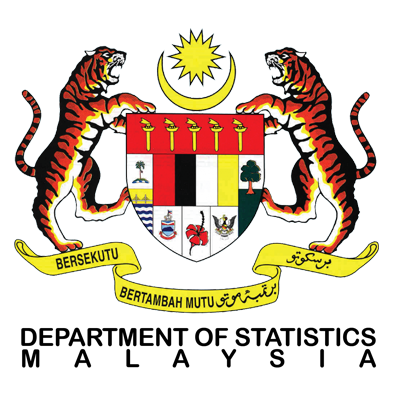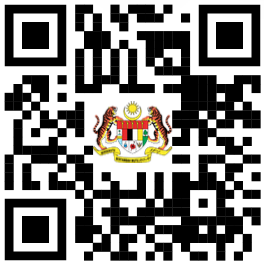Supply and Utilization Accounts Selected Agricultural Commodities
- Home
- Statistics
- Economy
- Agriculture
- Supply and Utilization Accounts Selected Agricultural Commodities
Supply and Utilization Accounts Selected Agricultural Commodities, Malaysia 2016-2020
Supply and Utilization Accounts Selected Agricultural Commodities, Malaysia 2015-2019 29 November 2019
Supply and Utilization Accounts Selected Agricultural Commodities, Malaysia 2014-2018 30 November 2018
Supply and Utilization Accounts Selected Agricultural Commodities, Malaysia 2013-2017 22 December 2017
Supply and Utilization Accounts Selected Agricultural Commodities, Malaysia 2012-2016 20 December 2016
Supply and Utilization Accounts Selected Agricultural Commodities, Malaysia 2011-2015 31 December 2015
Supply and Utilization Accounts Selected Agricultural Commodities, Malaysia 2010-2014 Show all release archives
Overview
Import Dependency Ratio (IDR) shows the Nation continues to depend on food imports, import of food amounted to RM55.5 billion
This publication presents statistics on production, exports and imports, and indicators of self-sufficiency ratio, import dependency ratio, and per capita consumption for 45 selected agricultural commodities comprise of three categories namely crops, livestock and fisheries.
Agriculture sector was one of the economic pillars to the country’s economy in its early stage of development with a share of 28.8 per cent in 1970 and 22.9 per cent in 1980. Nevertheless, in 1990 the share of Agriculture sector (16.3%) was overtaken by the Manufacturing sector (24.6 %) following the advancement of Manufacturing sector that reflected the success of Malaysia’s Industrial Master Plan – Phase 1. As of 2020, the share of Agriculture stood at 7.4 per cent to overall Gross Domestic Sector (GDP). In the recent years, the share of Malaysia’s Agriculture sector to the economy is comparatively small compared to our neighbouring countries such as Indonesia (13.7%) and Thailand (8.6%).
In 2020, 19 items under the selected agricultural commodities recorded Self-Sufficiency Ratio (SSR) more than 100.0 per cent as compared to 25 items in 2019. This was due to the implementation of Movement Control Order (MCO) to curb COVID-19 pandemic whereby only essential services were allowed to operate with restricted working hours and minimum number of employees which affected the production.
According to Food and Agriculture Organization (FAO), SSR describes the extent to which the supply (production) of agricultural commodities can meet the domestic demands. The SSR which obtained 100.0 per cent or more indicates the supply or production of agricultural commodities is sufficient to meet the country’s demands and vice versa.
Supply of eight fruits in 2020 was sufficient to fulfil the local demands with SSR of more than 100.0 per cent. Papaya recorded the highest SSR at 156.0 per cent (2019: 153.1%) followed by watermelon, 139.4 per cent (2019: 161.3%) and starfruit, 117.3 per cent (2019: 132.8%).
Seven types of selected vegetables have adequate supply for domestic needs namely tomato with 123.7 per cent (2019: 131.2%), lettuce ,114.0 per cent (2019: 112.5%), brinjal, 112.3 per cent (2019: 119.3%) and cucumber, 112.1 per cent (2019: 110.8%).
SSR for chicken/ duck eggs is the only item in livestock category that exceed 100.0 per cent at 113.5 per cent (2019: 117.8%). Meanwhile, for fisheries, tuna’s SSR stood at 108.1 per cent (2019: 101.3%) and shrimp, 101.7 per cent (2019: 103.0%).
Among the reasons that may hinder the performance of Agriculture sector is higher cost in raw materials especially for the commodities related to food products. For the last ten years, the index of foodstuff and feed stocks increased 24.4 per cent. Most feeding stuff for animal was imported mainly from Argentina, while for fertilisers, were from Canada and China. Imports of feeding stuff for animals amounted at RM4.6 billion in 2020, while fertiliser at RM3.2 billion.
Efforts to rejuvenate the food-based agriculture sector through technological adoption will be able to boost agricultural production as well as addressing the unemployment issues. As the number of unemployed persons at national level surpassed pre-pandemic threshold and remained high at 768.7 thousand persons in June 2021, Agriculture industry offered jobs and career opportunity especially for youth and graduates which may also resolve the labour shortages in this industry.
The scale of the COVID-19 pandemic had affected the international trade and globalisation, with the virus spreading along established trade route. The pandemic also affects both supply and demand. In 2020, 24 out of 45 items showed declining trend of Import Dependency Ratio (IDR) largely contributed by external trade restriction due to prolong pandemic.
IDR explains a country's dependence on imports of agricultural commodities to meet domestic needs. The higher IDR shows the more supply of agricultural commodities to be imported. Malaysia's dependency on imports for agricultural commodities increased to 13.7 per cent from 7.3 per cent over 28 years (1987-2015). In 2020, Malaysia imported RM55.5 billion food products as compared to RM33.8 billion of exports. The fastest increase in imports compared to exports has led to an increase in the trade deficit of food products amounted to RM21.7 billion in 2020, increased 24.9 per cent as compared to the previous year. It is also observed that imports of food accumulated to RM482.8 billion for the last 10 years, while exports amounted to RM296 billion.
In addition, Malaysia is also highly dependent on imports of mutton (RM879.4 million), mango (RM87.9 million), coconut (RM266.1 million) and beef (RM2.2 billion) to meet domestic demand. More than 70.0 per cent of imported mutton was from Australia while mango, coconut and beef were mainly imported from Thailand, Indonesia and India respectively.
From the point of IDR, eight items in 2020 exceed 50.0 per cent, namely cuttlefish (2020: 52.2%; 2019: 37.4%), fresh milk (2020: 53.5%; 2019: 43.9%), round cabbage (2020: 63.6%; 2019: 60.9%), chilli (2020: 72.4%, 2019: 73.6%), beef (2020: 78.1%; 2019: 77.1%), ginger (2020: 81.5%; 2019: 84.3%), mango (2020: 86.2%; 2019: 73.5%) and mutton (2020: 90.4%; 2019: 88.2%). These IDR values reaffirmed that Malaysia is highly dependent on imports of mutton, mango and beef to meet domestic demand.
In meeting the consumers’ needs and demands in the country, food products must also be imported from the rest of the world especially onion, dairy products, coffee, wheat flour, tea, shallots, potato and cooking oil. Based on the Household Expenditure Survey Report, Malaysia, 2019, these items represented 14.1 per cent from the item that was frequently spent by the household. The imports quantity of onion was the highest in 2020, 436.0 million tonnes, decreased by 8.4 per cent. This was followed by dairy products (336.4 million tonnes, -3.1%) and coffee (108.9 million tonnes, -5.2%).
Chicken/ duck eggs is one of the main sources of protein which is affordable and easily obtained. On the other hand, other sources of protein highly consumed by Malaysian households particularly chicken, meat and fish & seafood though easily obtained, the prices continue to increase. The price of ikan kembung was RM14.78/kg in 2020 (2019: RM14.71/kg), local meat RM32.19/kg (2019: RM31.99/kg) while the price of eggs declined to RM3.58 per 10 pieces in 2020 (2019: RM3.97 per 10 pieces). The consumer price index for eggs was down negative 6.8 per cent in 2020 as compared to 2019.
The Per Capita Consumption (PCC) of chicken/ duck eggs increased to 20.7 kilograms per year from 16.3 kilograms per year in 2019. Apart from chicken/ duck eggs, the PCC of mutton and beef also increased to 1.3 kilograms per year (2019: 1.1 kg/year) and 5.6 kilograms per year (2019: 5.4 kg/year) respectively in 2020. Sardine and shrimp were among the items that showed an increase in fisheries commodity with 2.5 kilograms per year (2019) to 2.9 kilograms per year (2020) and 4.0 kilograms per year (2019) to 4.1 kilograms per year in 2020 respectively. Meanwhile, PCC for crops commodity showed an increase namely mango (2019: 1.5 kg/year, 2020: 1.8 kg/year), tomato (2019: 3.6 kg/year, 2020: 4.2 kg/year) and sweet corn (2019: 1.5 kg/year, 2020: 1.7 kg/year). Similarly, there was a decline in PCC in 2020 as compared to 2019 that was poultry meat, pork and banana by 1.83, 0.49 and 0.48 kilograms per year respectively.
Supply and Utilization Account (SUA) serves as a very useful tool in analysing the trend of supply and utilization of agricultural commodities in the country as well as a mechanism to evaluate national agriculture situation, particularly in determining the country’s food security. At global level, Malaysia ranked 43rd out 113 countries in the Global Food Security Index (GFSI) with a score of 67.9 for year 2020. The GFSI deliberates three core principal issues of affordability, availability and quality in food security measures. Moving forward, DOSM will strengthen the compilation of SUA by enhancing the coverage of items to provide a more comprehensive picture of food balance sheet and food security.
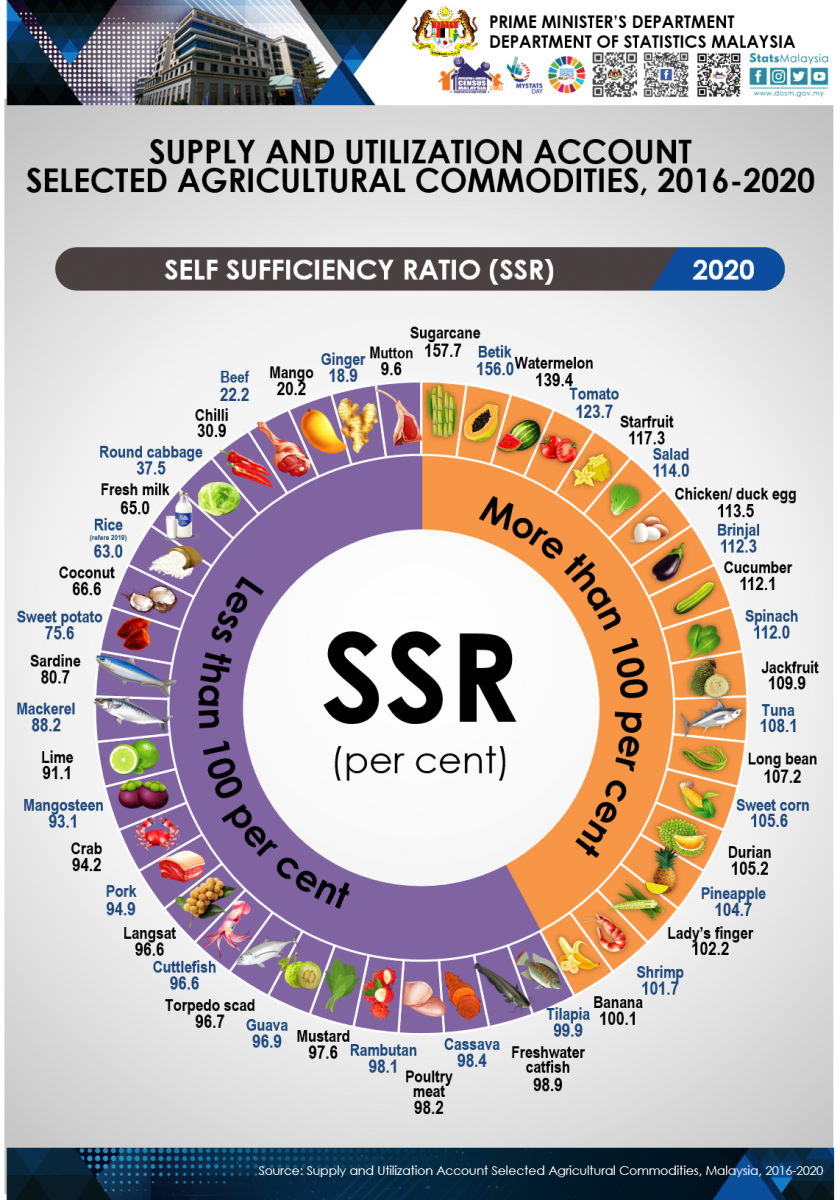
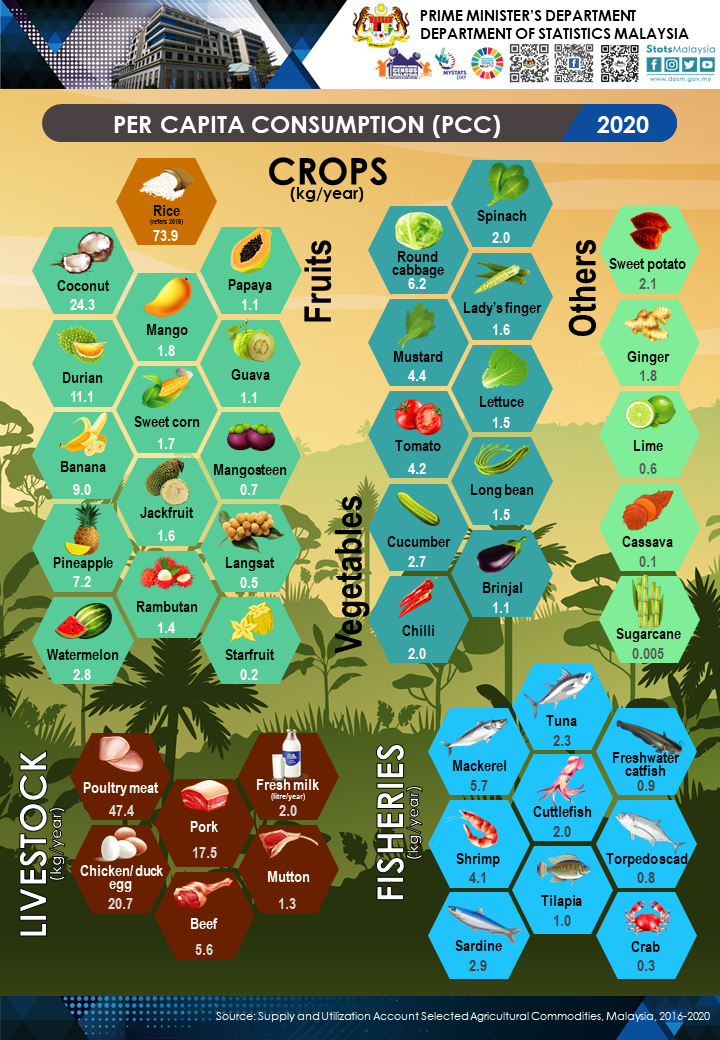
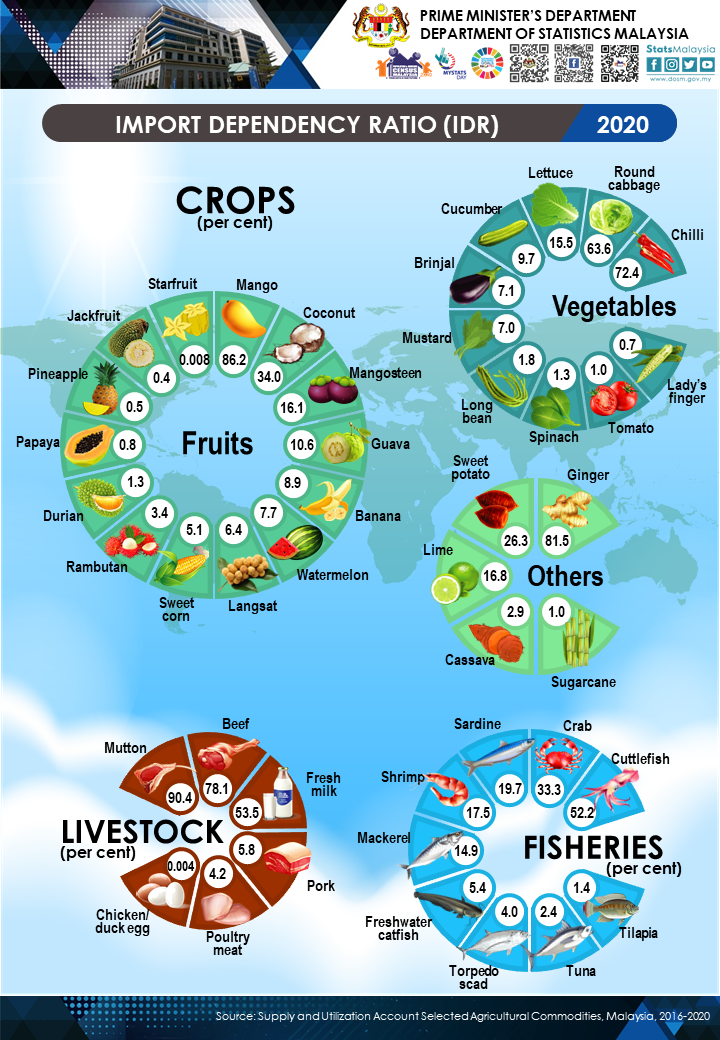
The full publication of the Supply and Utilization Accounts Selected Agricultural Commodities, Malaysia 2016-2020 can be downloaded through eStatistik Portal.
For more details, please refer to Department's portal: www.dosm.gov.my
Released By:
DATO' SRI DR. MOHD UZIR MAHIDIN
CHIEF STATISTICIAN MALAYSIA
DEPARTMENT OF STATISTICS, MALAYSIA
![]() DrUzir_Mahidin
DrUzir_Mahidin ![]()
![]() Dr_Uzir
Dr_Uzir
26 August 2021
Contact person:
Mohd Yusrizal Ab Razak
Public Relation Officer
Strategic Communication and International Division
Department of Statistics, Malaysia
Tel : +603-8885 7942
Fax : +603-8888 9248
Email : yusrizal.razak[at]dosm.gov.my
Subscribe
Newsletter
Subscribe to our newsletter and stay updated
For interviews, press statement and clarification to the media, contact:
Baharudin Mohamad
Public Relation Officer
Email: baharudin[at]dosm.gov.my
Phone: 03 8090 4681
Not found what you looking for? Request data from us, through
Go to eStatistik
Email: data[at]dosm.gov.my
Phone: 03 8885 7128 (data request)
